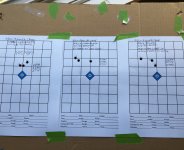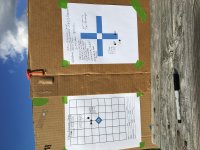After a vacation I am back to reloading for my 30-06. Using new Nosler cases, prepping includes just running the new VLD reamer in the neck to easy the start of the 180 Partitions that I am using. The base to shoulder on the new brass is within .002 - .003" of my as fired cases so I have not full length sized them before testing.
Prior testing of the same load using once fired cases yielded about 75 fps faster loads than the new brass, 2,789 fps vs 2,713 fps. I must admit, small sample velocities.
After cleaning the once fired cases in the Hornady Sonic cleaner I shoot them Hornady One shot lube from a slightly above position, thus allowing a little lube to enter the neck. Is it conceivable that the lube in the once fired case neck causes less neck tension, thus more velocity than the new cases?
Your thoughts on this issue are most appreciated. I think in the interim I will run a Q-Tip with a small amount of One Shot Lube on it into the neck of a few new cases and check the results.
Thanks in advance. Rol
Prior testing of the same load using once fired cases yielded about 75 fps faster loads than the new brass, 2,789 fps vs 2,713 fps. I must admit, small sample velocities.
After cleaning the once fired cases in the Hornady Sonic cleaner I shoot them Hornady One shot lube from a slightly above position, thus allowing a little lube to enter the neck. Is it conceivable that the lube in the once fired case neck causes less neck tension, thus more velocity than the new cases?
Your thoughts on this issue are most appreciated. I think in the interim I will run a Q-Tip with a small amount of One Shot Lube on it into the neck of a few new cases and check the results.
Thanks in advance. Rol








